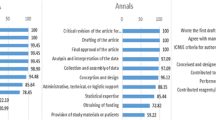Abstract
Current research performance assessment criteria contribute to some extent to author inflation per publication. Among various indicators for evaluating the quality of research with multiple authors, harmonic counting is relatively superior in terms of calculation, scientific ethics, and application. However, two important factors in harmonic counting are not yet clearly understood. These factors are the perceptions of scientists regarding the (1) corresponding author and (2) equally credited authors (ECAs). We carry out a survey investigation on different perceptions of author position versus contribution among medical researchers with different subfields and professional ranks in China, in order to provide several pieces of evidence on the aforementioned factors. We are surprised to find that researchers with different professional ranks tend to largely acknowledge their own contribution in collaborative research. Next, we conduct an empirical study to measure individual’s citation impact using inflated counts versus harmonic counts. The results indicate that harmonic h-index cannot reflect the high peak of harmonic citations. Therefore, we use (1) harmonic R-index to differentiate authors based on the harmonic citations of each paper belonging to their respective h-cores; and (2) Normalization harmonic (h, R) index as a meaningful indicator in ranking scientists. Using a sample of 40 Ph.D. mentors in the field of cardiac and cardiovascular diseases, harmonic counts can distinguish between scientists who are often listed as major contributors and those regularly listed as co-authors. This method may also discourage unethical publication practices such as ghost authorship and gift authorship.




Similar content being viewed by others
Notes
Novelty Search is to appraise the novelty of a research proposal or result by search, investigation and comparison of related bibliographic documents. An analytical report will be offered. The Institute of Medical Information (IMI) and Library, Chinese Academy of Medical Sciences and Peking Union Medical College (CAMS & PUMC), was designated as one of the national level science and technology novelty search institutes and ranked first in medical field in China.
References
Abbas, A. M. (2011). Weighted indices for evaluating the quality of research with multiple authorship. Scientometrics, 88, 107–131.
Abbott, A., Cyranoski, D., Jones, N., et al. (2010). Metrics: do metrics matter? Nature, 465, 860–862.
Akhabue, E., & Lautenbach, E. (2010). “Equal” contributions and credit: an emerging trend in the characterization of authorship. Annals of Epidemiology, 20, 868–871.
Aksnes, D. W., Schneider, J. W., & Gunnarsson, M. (2012). Ranking national research systems by citation indicators. A comparative analysis using whole and fractionalised counting methods. Journal of Informetrics, 6, 36–43.
Batista, P. D., Campiteli, M. G., Kinouchi, O., et al. (2006). Is it possible to compare researchers with different scientific interests? Scientometrics, 68, 179–189.
Bornmann, L., Mutz, R., & Daniel, H. D. (2008). Are there better indices for evaluation purposes than the h index? A comparison of nine different variants of the h index using data from biomedicine. Journal of the American Society for Information Science and Technology, 59, 830–837.
Burrows, S., & Moore, M. (2011). Trends in authorship order in biomedical research publications. Journal of Electronic Resources in Medical Libraries, 8, 155–168.
Castillo, A. (2009). Authorship and bylines. American Journal of Neuroradiology, 30, 1455–1456.
Chai, J. C., Hua, P. H., Rousseau, R. et al. (2008). Adaptive pure h-index. In Proceedings of 4th international conference on Webometrics, informetrics and scientometrics, 1–6.
Cleary, M., Jackson, D., Walter, G., et al. (2012). Editorial: location, location, location—the position of authors in scholarly publishing. Journal of Clinical Nursing, 21, 809–811.
Costas, R., & Bordons, M. (2011). Do age and professional rank influence the order of authorship in scientific publications? Some evidence from a micro-level perspective. Scientometrics, 88, 145–161.
Du, J., Zhang, B., Li, Y., et al. (2011). A causational analysis of scholars’ years of active academic careers vis-à-vis their academic productivity and academic influence. Chinese Journal of Library and Information Science, 4, 77–91.
Eggert, L. D. (2011). Best practices for allocating appropriate credit and responsibility to authors of multi-authored articles. Front Psychol, 2, 196.
Egghe, L. (2008). Mathematical theory of the h- and g-index in case of fractional counting of authorship. Journal of the American Society for Information Science and Technology, 59, 1608–1616.
Fadeel, B. (2009). But many that are first shall be last; and the last shall be first. Faseb Journal, 23, 1283.
Gaeta, T. J. (1999). Authorship: “law” and order. Academic Emergency Medicine, 6, 297–301.
Galam, S. (2011). Tailor based allocations for multiple authorship: a fractional gh-index. Scientometrics, 89, 365–379.
Ganten, D., Semenza, G. L., & Nolte, C. (2009). Fostering trust—J Mol Med’s scientific integrity policy. Journal of Molecular Medicine, 87, 1–2.
Glanzel, W. (2007). The R- and AR-indices: complementing the h-index —Comments. Chinese Science Bulletin, 52, 863.
Greene, M. (2007). The demise of the lone author. Nature, 450, 1165.
Hagen, N. T. (2008). Harmonic allocation of authorship credit: source-level correction of bibliometric bias assures accurate publication and citation analysis. PLoS One, 3, e4021.
Hagen, N. T. (2010a). Harmonic publication and citation counting: sharing authorship credit equitably—not equally, geometrically or arithmetically. Scientometrics, 84, 785–793.
Hagen, N. T. (2010b). Deconstructing doctoral dissertations: how many papers does it take to make a PhD? Scientometrics, 85, 567–579.
Hagen, N. T. (2010c). Harmonic partitioning of authorship credit facilitates bottom-up bibliometric research. In 15th Nordic Workshop on Bibliometrics and Research Policy, 28–29 September 2010 University of Bergen. http://www.ub.uib.no/felles/dok/Bibliometrics-2010/Hagen-Bergen-2010.pdf.
Hirsch, J. E. (2010). An index to quantify an individual’s scientific research output that takes into account the effect of multiple coauthorship. Scientometrics, 85, 741–754.
Hu, X. J. (2009). Loads of special authorship functions: linear growth in the percentage of “Equal First Authors” and corresponding authors. Journal of the American Society for Information Science and Technology, 60, 2378–2381.
Hu, X. J., Rousseau, R., & Chen, J. (2010). In those fields where multiple authorship is the rule, the h-index should be supplemented by role-based h-indices. Journal of Information Science, 36, 73–85.
Hunt, G. E., Cleary, M., & Walter, G. (2010). Psychiatry and the Hirsch h-index: the relationship between journal impact factors and accrued citations. Harvard Review Psychiatry, 18, 207–219.
Jin, B. H., Liang, L. M., Rousseau, R., et al. (2007). The R- and AR-indices: complementing the h-index. Chinese Science Bulletin, 52, 855–863.
Joseph, K., Laband, D. N., & Patil, V. (2005). Author order and research quality. Southern Economic Journal, 71, 545–555.
Lehmann, S., Jackson, A. D., & Lautrup, B. E. (2006). Measures for measures. Nature, 444, 1003–1004.
Leydesdorff, L., & Opthof, T. (2010). Normalization at the field level: fractional counting of citations (Rejoinder). Journal of Informetrics, 4, 644–646.
Leydesdorff, L., & Shin, J. C. (2011). How to evaluate universities in terms of their relative citation impacts: fractional counting of citations and the normalization of differences among disciplines. Journal of the American Society for Information Science and Technology, 62, 1146–1155.
Liu, X. Z., & Fang, H. (2012). Fairly sharing the credit of multi-authored papers and its application in the modification of h-index and g-index. Scientometrics, 91, 37–49.
Macrina, F. (2005). Scientific integrity: Text and cases in responsible conduct of research (3rd ed.). Washington, DC: ASM Press.
Mattsson, P., Sundberg, C. J., & Laget, P. (2011). Is correspondence reflected in the author position? A bibliometric study of the relation between corresponding author and byline position. Scientometrics, 87, 99–105.
Prathap, G. (2011). The fractional and harmonic p-indices for multiple authorship. Scientometrics, 86, 239–244.
Retzer, V., & Jurasinski, G. (2009). Towards objectivity in research evaluation using bibliometric indicators—a protocol for incorporating complexity. Basic and Applied Ecology, 10, 393–400.
Schreiber, M. (2008). To share the fame in a fair way, h(m) modifies h for multi-authored manuscripts. New Journal of Physics, 10, 040201.
Schreiber, M. (2009). A case study of the modified Hirsch index h(m) accounting for multiple coauthors. Journal of the American Society for Information Science and Technology, 60, 1274–1282.
Smith, E., & Williams-Jones, B. (2012). Authorship and responsibility in health sciences research: a review of procedures for fairly allocating authorship in multi-author studies. Science and Engineering Ethics, 18, 199–212.
Tao, T. Z., Bo, L. L., Wang, F., et al. (2012). Equal contributions and credit given to authors in anesthesiology journals during a 10-year period. Scientometrics, 91, 1005–1010.
Tol, R. S. J. (2011). Credit where credit’s due: accounting for co-authorship in citation counts. Scientometrics, 89, 291–299.
Tscharntke, T., Hochberg, M. E., Rand, T. A., et al. (2007). Author sequence and credit for contributions in multiauthored publications. PLoS Biology, 5, 13–14.
Vinther, S., & Rosenberg, J. (2012). Appearance of ghost and gift authors in Ugeskrift for Laeger and Danish Medical Journal. Danish Medical Journal, 59, A4455.
Wager, E. (2009). Recognition, reward and responsibility: why the authorship of scientific papers matters. Maturitas, 62, 109–112.
Walker, R. L., Sykes, L., Hemmelgarn, B. R., et al. (2010). Authors’ opinions on publication in relation to annual performance assessment. BMC Medical Education, 10, 1–6.
Wan, J. K., Hua, P., & Rousseau, R. (2007). The pure h-index: calculating an author’s h-index by taking co-authors into account. Collnet Journal of Scientometrics and Information Management, 1, 1–5.
Wang, F., Tang, L., Bo, L. L., et al. (2012). Equal contributions and credit given to authors in critical care medicine journals during a 10-year period. Critical Care Medicine, 40, 967–969.
Wang, G. & Yang, J. (2010). Axiomatic quantification of co-authors’ relative contributions. arXiv:1003.3362.
Wren, J. D., Kozak, K. Z., Johnson, K. R., et al. (2007). The write position. A survey of perceived contributions to papers based on byline position and number of authors. EMBO Reports, 8, 988–991.
Wyatt, P. J. (2012). Too many authors, too few creators. Physics Today, 65, 9–10.
Zbar, A., & Frank, E. (2011). Significance of authorship position: an open-ended international assessment. American Journal of the Medical Sciences, 341, 106–109.
Zhang, C. T. (2009). A proposal for calculating weighted citations based on author rank. EMBO Reports, 10, 416–417.
Acknowledgments
We are grateful to Hagen Nils T, Yue Weiping, Wu Yishan, Xu Peiyang and Liu Yuxian for improving the research design, linguistic content, data analysis, and logical flow of the manuscript. We would like to thank Li Yang for the help during data collection and examination of the empirical study. This study was supported by the Institute of Medical Information of the Chinese Academy of Medical Sciences (Grant No. 11R0117).
Author information
Authors and Affiliations
Corresponding author
Additional information
Du Jian and Tang Xiaoli designed the study. Du Jian performed data collection and statistical analysis, and also wrote a first draft of the manuscript that was critically examined by Tang Xiaoli. Tang Xiaoli coordinated the study.
Rights and permissions
About this article
Cite this article
Jian, D., Xiaoli, T. Perceptions of author order versus contribution among researchers with different professional ranks and the potential of harmonic counts for encouraging ethical co-authorship practices. Scientometrics 96, 277–295 (2013). https://doi.org/10.1007/s11192-012-0905-4
Received:
Published:
Issue Date:
DOI: https://doi.org/10.1007/s11192-012-0905-4




